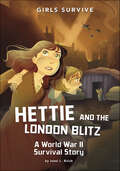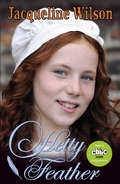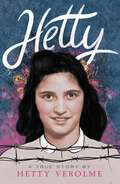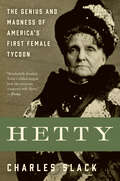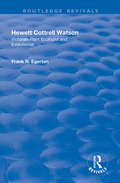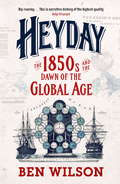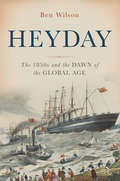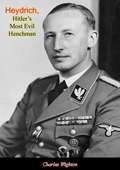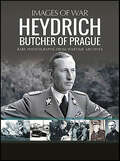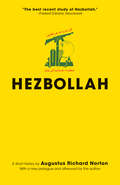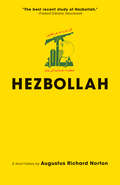- Table View
- List View
Heteronormativity in Eighteenth-Century Literature and Culture
by Ana de Boe Abby CoykendallThe resurgence of marriage as a transnational institution, same-sex or otherwise, draws upon as much as it departs from enlightenment ideologies of sex, gender, and sexuality which this collection aims to investigate, interrogate, and conceptualize anew. Coming to terms with heteronormativity is imperative for appreciating the literature and culture of the eighteenth century writ large, as well as the myriad imaginaries of sex and sexuality that the period bequeaths to the present. This collection foregrounds British, European, and, to a lesser extent, transatlantic heteronormativities in order to pose vital if vexing questions about the degree of continuity subsisting between heteronormativities of the past and present, questions compounded by the aura of transhistoricity lying at the heart of heteronormativity as an ideology. Contributors attend to the fissures and failures of heteronormativity even as they stress the resilience of its hegemony: reconfiguring our sense of how gender and sexuality came to be mapped onto space; how public and private spheres were carved up, or gendered and sexual bodies socially sanctioned; and finally how literary traditions, scholarly criticisms, and pedagogical practices have served to buttress or contest the legacy of heteronormativity.
Hettie and the London Blitz: A World War II Survival Story (Girls Survive)
by Jenni L. WalshLondon schoolgirl Hettie hears the whispers and sees the worry creeping across her parents' faces. She watches as the windows in her home are blacked out. She helps her dad build a bomb shelter. She learns how to wear a gas mask. War, led by Adolf Hitler, is stomping its feet at Great Britain's doorstep, and Hettie knows only one thing for certain: When the bombs come, it will take all the courage she has to be brave and survive.
Hettie and the London Blitz: A World War II Survival Story (Girls Survive)
by Jenni L. WalshLondon schoolgirl Hettie hears the whispers and sees the worry creeping across her parents' faces. She watches as the windows in her home are blacked out. She helps her dad build a bomb shelter. She learns how to wear a gas mask. War, led by Adolf Hitler, is stomping its feet at Great Britain's doorstep, and Hettie knows only one thing for certain: When the bombs come, it will take all the courage she has to be brave and survive.
Hetty Feather (Hetty Feather #1)
by Jacqueline WilsonThe mega-bestselling tale of fiery, spirited Victorian foundling, Hetty Feather.London, 1876. Hetty Feather is just a tiny baby when her mother leaves her at the Foundling Hospital. The Hospital cares for abandoned children - but Hetty must first live with a foster family until she is big enough to go to school. Life in the countryside is sometimes hard, but with her foster brothers, Jem and Gideon, Hetty helps in the fields and plays vivid imaginary games. Together they sneak off to visit the travelling circus, and Hetty is mesmerised by the show - especially the stunning Madame Adeline and her performing horses.But Hetty's happiness is threatened once more when she must return to the Foundling Hospital to begin her education. The new life of awful uniforms and terrible food is a struggle for her, and she desperately misses her beloved Jem. But now she has the chance to find her real mother. Could she really be the wonderful Madame Adeline? Or will Hetty find the truth is even more surprising? Jacqueline Wilson will surprise and delight old fans and new with this utterly original historical novel. The first book featuring feisty Victorian heroine, Hetty Feather, this is a compelling, moving, funny and totally fascinating tale that will thrill and captivate readers.
Hetty: A True Story
by Hetty VerolmeHetty was just twelve years old in 1943 when her family was torn apart by the Nazis. Rounded up from their home in Amsterdam, Hetty and her brothers were sent to the children's house at Bergen-Belsen concentration camp. There, Hetty became known as the 'Little Mother', helping to look after the babies, toddlers and children through those terrible years. In her direct and powerful style, Hetty recalls one of the remarkable, largely untold stories of the Holocaust. An extraordinary true story of hope and resilience.
Hetty: The Genius and Madness of America's First Female Tycoon
by Charles SlackThis acclaimed biography of the Gilded Age&’s Queen of Wall Street is &“a must-read for all aspiring moguls&” (Regina Herzlinger, Harvard Business School). When J. P. Morgan called a meeting of New York's financial leaders after the stock market crash of 1907, Hetty Green was the only woman in the room. The Guinness Book of World Records memorialized her as the World's Greatest Miser, and, indeed, this unlikely robber baron—who parlayed a comfortable inheritance into a fortune that was worth about 1.6 billion in today's dollars—was frugal to a fault. But in an age when women weren't even allowed to vote, never mind concern themselves with interest rates, she lived by her own rules. In Hetty, Charles Slack reexamines her life and legacy, giving us, at long last, a splendidly &“nuanced portrait&” (Newsweek) of one of the greatest—and most eccentric—financiers in American history. This P.S. edition features an extra 16 pages of insights into the book, including author interviews, recommended reading, and more. &“[Hetty&’s] wry wit and colorful personality bring humor and pathos to this story. . . . [R]eaders cannot help from cheering for her at every turn.&” —Booklist &“An exemplary retelling for a new generation.&” —Kirkus Reviews &“Entertaining. . . . Slack . . . concentrates on telling a good story and telling it well.&” —Publishers Weekly &“Wonderfully detailed.&” —Forbes &“Page-turning.&” —Richmond Times-Dispatch &“Fascinating.&” —New York Post
Heuristic Rhetoric: Principles and Practice (Rhetoric, Politics and Society)
by Gábor TahinThis book introduces a novel approach to the analysis and practice of persuasive speaking and writing: heuristic rhetoric. The new method has evolved to fulfil the need at universities, government departments, political organisations, business enterprises and other public institutions for a modern practical alternative to classical rhetoric, which is, in the author’s view, no longer capable of giving a complete description of contemporary, predominantly mediatised, forms of public persuasive discourse, whilst other competing disciplines, such as critical discourse analysis or strategic manoeuvring, have not yet produced a set of tools, which have the comprehensive nature and practical orientation of Classical Greek and Roman rhetorical system. The book expounds heuristic rhetoric as an inter-disciplinary method to develop advanced skills of critical and strategic reasoning. Applying a novel set of principles for the strategic analysis of persuasive reasoning in complex rhetorical situations, the method emphasizes preparing and continuously adjusting argumentation according to the demands of unpredictable circumstances.
Heuristic Strategies in the Speeches of Cicero
by Gábor TahinThis book introduces a new form of argumentative analysis: rhetorical heuremes. The method applies the concepts of heuristic thinking, probability, and contingency in order to develop a better understanding of complex arguments in classical oratory. A new theory is required because Greek and Roman rhetoric cannot provide detailed answers to problems of strategic argumentation in the analysis of speeches. Building on scholarship in Ciceronian oratory, this book moves beyond the extant terminology and employs a concept of heuristic reasoning derived from the psychology of decision making and mathematical problem solving. The author analyses selected passages from Cicero's forensic speeches where arguments of probability are deployed, and shows that the Sophistic concept of probability can link ancient rhetoric and modern theories of argumentation. Six groups of heuremes are identified, each of which represents a form of probabilistic reasoning by which the orator plays upon the perception of the jurors.
Heusinger of the Fourth Reich
by Charles R. Allen“Within a year after Potsdam, this mighty Agreement was given its funeral by the then Secretary of State, Mr. James Byrnes, in his Stuttgart speech. Mr. Churchill, with President Truman at his side, adumbrated the ultimate reversal of our German policy in his Fulton speech which formally started the Cold War. A speech by Herbert Hoover to a small group of Germans whom I had assembled in Stuttgart in January 1947 was also significant: he told them that the U.S. expected their support in the coming struggle with “the atheistic barbarians of the East.”Looking back on this reversal of policy, it seems to me that the Power Elite’s major problem was to propagandize our people to accept German remilitarization in the defense of “freedom.” Heusinger of the Fourth Reich brilliantly traces step-by-step, with a scholarly documentation which cannot for a moment be challenged, how the American Power Elite has helped this criminal conspiracy, the German General Staff, to return to power with the largest, most powerful military machine in Europe today: the aggressive, Nazi-oriented and Nazi-commanded West German military establishment.Through this book, the author, Charles R. Allen, Jr., a gifted young political analyst, completely demolishes the official United States myth that the General Staff was something separate and different from Hitler’s murderous Reich; that it was a non-political, purely professional group innocently carrying out its sworn duty to serve the German people and der Führer because the General Staff’s oath was taken “under God.” What blasphemy!”-Introduction
Hewett Cottrell Watson: Victorian Plant Ecologist and Evolutionist (Routledge Library Editions: The Victorian World #17)
by Frank N. EgertonFirst published in 2003. Hewett Cottrell Watson was a pioneer in a new science not yet defined in Victorian times – ecology – and was practically the first naturalist to conduct research on plant evolution, beginning in 1834. The correspondence between Watson and Darwin, analysed for the first time in this book, reveals the extent to which Darwin profited from Watson’s data. Darwin’s subsequent fame, however, is one of the reasons why Watson became almost forgotten. This biography traces both the influences and characteristics that shaped Watson’s outlook and personality, and indeed his science, and the institutional contexts within which he worked. At the same time, it makes evident the extent of his real contributions to the science of the plant ecology and evolution.
Hewett Cottrell Watson: Victorian Plant Ecologist and Evolutionist (Routledge Library Editions: The Victorian World Ser. #17)
by Frank N. EgertonThis title was first published in 2003. Hewett Cottrell Watson was a pioneer in a new science not yet defined in Victorian times - ecology - and was practically the first naturalist to conduct research on plant evolution, beginning in 1834. His achievement in British science is commemorated by the fact that the Botanical Society of the British Isles named its journal after him - Watsonia - but of greater significance to the history of science is his contribution to the development of Darwin’s theory of evolution. The correspondence between Watson and Darwin, analysed for the first time in this book, reveals the extent to which Darwin profited from Watson’s data. Darwin’s subsequent fame, however, is one of the reasons why Watson became almost forgotten. At the same time, Watson can be called a classic Victorian eccentric, and his other ambition, in addition to promoting and organizing British botany, was to carry forward the cause of phrenology. Indeed, he was a more daring theoretician in phrenology than ever he was in botany, but in the end he abandoned it, not being able to raise phrenology to the level of an accepted science. This biography traces both the influences and characteristics that shaped Watson’s outlook and personality, and indeed his science, and the institutional contexts within which he worked. At the same time, it makes evident the extent of his real contributions to the science of plant ecology and evolution.
Hexen-Politik im frühmodernen Europa (1400 – 1800)
by Stephan QuenselWarum glaubt eine ganze Gesellschaft, dass es Hexen gibt, die man verbrennen muss? Welche Rollen übernahmen dabei jeweils der sich herausbildende ‚Staat‘, die Professionen der Kleriker und Juristen und das daran beteiligte Publikum? Und wie konnte dieses Projekt beendet werden?Aus soziologischer Sicht ergeben die Befunde der rezenten internationalen Hexen-Forschung ein Modell einer allgemeineren, höchst ambivalent besetzten, ‚pastoralen‘ Grundhaltung, nach der ein Hirte gleichermaßen für das Wohl seiner Herde wie für deren irrende Schafe zu sorgen habe.Der erste Hauptteil beschreibt die klerikale Ausgangs-Situation, die auf der Grundlage der noch immer dominierenden magisch-religiösen Mentalität im 15. Jahrhundert das ‚dominikanisch‘ dämonologische Hexen-Modell entwickelte.Ein Modell, so der zweite Teil des Buches, das dann im Laufe des 16. Jahrhunderts im westlichen Europa zunehmend in die Hände der gar nicht so unschuldigen Juristen geriet. Von dort entwickelte es sich zu einer juristischen Hexen-Verfolgung, die von der Dorf-Hexe über die Massenverfolgungen bis hin zu den späten Kinder-Hexen das früh-europäische Hexen-Modell realisierte.Der dritte Teil beschreibt, wie die Hexen-Verfolgungen gegen Ende des 17. Jahrhunderts als allgemeines Hexen-‚Politik‘-Spiel im Übergang vom Konfessions-Staat zum (Hof-)‚Beamten‘-Staat langsam an Bedeutung verloren.
Hey America!: The Epic Story of Black Music and the White House
by Stuart CosgroveThis is the untold story of black music – its triumph over racism, segregation, undercapitalised record labels, media discrimination and political anxiety – told through the perspective of the most powerful office in the world: from Louis Armstrong's spat with President Eisenhower and Eartha Kitt's stormy encounter with Lady Bird Johnson to James Brown's flirtation with Nixon, Reaganomics and the 'Cop Killer' scandal. Moving, insightful and wide-ranging, Hey America! charts the evolution of sixties soul from the margins of American society to the mainstream, culminating in the rise of urban hip-hop and the dramatic stand-off between Donald Trump and the Black Lives Matter movement.
Hey Presto!: Swift and the Quacks
by Hugh Ormsby-LennonIn this book the author reveals how medicine shows, both ancient and modern, galvanized Jonathan Swift’s imagination and inspired his wittiest satiric voices. Swift dubbed these multifaceted traveling entertainments his Stage-itinerant or “Mountebank’s Stage.” In the course of arguing that the stage-itinerant formed an irresistible model for A Tale of a Tub, Ormsby-Lennon also surmises that the mountebank’s stage will disclose that missing link, long sought, which connects the twin objects of Swift’s ire: gross corruptions in both religion and learning. In the early modern medicine show, the quack doctor delivered a loquacious harangue, infused with magico-mysticism and pseudoscience, high-astounding promises, and boastful narcissism. To help him sell his panaceas and snake-oil, he employed a Merry Andrew and a motley troupe of performers. From their stages, many quacks also peddled their own books, almanacs, and other ephemera, providing Grub Street with many of its best-sellers. Hacks practiced, quite literally, as quacks. Merry Andrew and mountebank traded costumes, whiskers, and voices. Swift apes them all in the Tale. Published by University of Delaware Press. Distributed worldwide by Rutgers University Press.
Hey, America, Your Roots Are Showing: Adventures in Discovering News-Making Connections, Unexpected Ancestors, and Long-Hidden Secrets, and Solving Historical Puzzles
by Megan SmolenyakThe acclaimed genealogist and New York Times–bestselling author reveals how she solved some of the most fascinating mysteries of family lineage. Part forensic scientist, part master sleuth, Megan Smolenyak has a unique way of digging up our historical roots. She discovered Barack Obama&’s Irish ancestry—and his relation to Brad Pitt. She revealed the true story of Ellis Island&’s first immigrant, Annie Moore. And she shed light on a startling link between politicians Al Sharpton and Strom Thurmond. In Hey America, Your Roots Are Showing, the &“Indiana Jones of genealogy&” reveals how she cracked these and other news-making cases. Along the way, she shares her own story of becoming genealogy&’s celebrity face. She even explains why her name is squared (Buzzy Jackson, author of Shaking the Family Tree). Whether she's scouring websites to uncover the surprising connections between famous figures or using cutting-edge DNA tests to locate family members of fallen soldiers dating back to the Civil War, Smolenyak's historical sleuthing is as provocative, richly layered, and exciting as America itself. &“Megan is a genealogist's dream, a forensic investigator who can also tell a great story.&” —Sam Roberts, The New York Times
Heydar Aliyev and the Foundations of Modern Azerbaijan
by Michael M. Gunter M. Hakan Yavuz Shamkhal AbilovThis edited book examines and analyses Heydar Aliyev, the architect and founder of modern, post-Soviet Azerbaijan. The editors of the volume discuss developments between 1993 and 2003 – a decade that saw the establishment of the institutional foundations of the current republic, the adoption of a new form of national identity, the redefinition of the concept of the Azerbaijani state, and the creation of a security establishment designed to gain control of territories Armenia had held since the 1988-1994 war over Karabakh. The book explains why this fateful period had far-reaching consequences for Azerbaijan as a fully formed state and society, as well as major implications for its political future and its geopolitical strategy.
Heyday: Britain and the Birth of the Modern World
by Ben Wilson'Excellent . . . This is narrative history of the highest quality' Andrew Lycett, Sunday Telegraph'Wonderfully engrossing and intelligent . . . clever and entertaining' Dominic Sandbrook, Sunday TimesHEYDAY brings to life one of the most extraordinary periods in modern history. The 1850s was a decade of breathtaking transformation, with striking parallels for our own times. The world was reshaped by technology, trade, mass migration and war. The global economy expanded fivefold, millions of families emigrated to the ends of the earth to carve out new lives, technology revolutionised communications, while steamships and railways cut across vast continents and oceans, shrinking the world and creating the first global age.In a fast-paced, kaleidoscopic narrative, the acclaimed historian Ben Wilson recreates this time of explosive energy and dizzying change, a rollercoaster ride of booms and bust, focusing on the lives of the men and women reshaping its frontiers. At the centre stands Great Britain. The country was the peak of its power as it attempted to determine the destinies of hundreds of millions of people. A dazzling history of a tumultuous decade, HEYDAY reclaims an often overlooked period that was fundamental not only in in the making of Britain but of the modern world.
Heyday: The 1850s and the Dawn of the Global Age
by Ben WilsonA global history of the 1850s, the turbulent decade that marked the peak of the Victorian era, the birth of modernity, and the beginning of the first global age
Heydrich, Hitler’s Most Evil Henchman
by Charles WightonTHE MAN WITH THE IRON HEARTHitler called him “The man with the iron heart”—yet Reinhard Heydrich was utterly different from those other iron men who served the Führer. Gifted with intellect, charm and great courage, Heydrich used his outstanding talents to create the Nazi Security Service, the notorious SD (Sicherheitsdienst), thereby becoming one of the most powerful figures—perhaps the most evil influence of all—in Nazi Germany.Charles Wighton, through unprecedented co-operation on both sides of the Iron Curtain, has had access to top secret Nazi Party files, to official sources in East Germany, to highly secret records in Czechoslovakia—and to the frank recollections of Heydrich’s widow. The result is a fascinatingly detailed revelation of the rise of this diabolical genius.Through Heydrich’s racial campaigns, which gathered their own momentum after his death, six million Jews were murdered by 1945. And yet this son of a cultured, upper-middle-class Roman Catholic family, who became the real power behind Himmler, was himself blackmailed by the Führer for possessing non-Aryan blood.In addition to clarifying this aspect of Heydrich’s astonishing career, the author throws new light, too, on “Plan Ost”, the blueprint for the extermination of thirty million Slavs, and on the mystery surrounding Heydrich’s assassination in 1942.Here, then, is the full story of the man with the iron heart—Heydrich, Hitler’s most evil henchman.
Heydrich: Butcher of Prague (Images of War)
by Ian BaxterReinhard Heydrich along with Heinrich Himmler, whose deputy he was, will always be regarded as one of the most ruthless of the Nazi elite. Even Hitler described him as ‘a man with an iron heart’. He established his fearsome reputation in the 1930s, as head of the Sicherheitsdienst (SD), the intelligence organization which neutralized opposition to the Nazi Party by murder and deportation. He organized Kristalnacht and played a leading role in the Holocaust, chairing the 1942 Wannsee Conference which formalized plans for the ‘Final Solution’. In addition, as head of the Einsatzgruppen murder squads in Eastern Europe he was responsible for countless murders. Appointed Deputy Reich-Protector of Bohemia and Moravia, he died of wounds inflicted by British trained SOE operatives in Prague in May 1942. The reprisals that followed his assassination were extreme by even the terrible standards of Nazi ruthlessness. Heydrich’s shocking and leading role in the Nazi regime is graphically portrayed in this Images of War book.
Heydrich: The Face of Evil
by Mario R. Dederichs"A chilling study of the man who masterminded the Holocaust…Heydrich was inhumanely cruel, ruthless, devious, shameless, a sixteen hour a day workaholic who was feared and loathed even by his closest colleagues.' — The Daily Telegraph ‘An impressive mix of psychological analysis, biography and historical reporting...Dederichs descends into Heydrich's personal abyss and describes it in a captivating and intelligible manner while not rejecting the scientific approach.’ – Die Rheinische Adolph Hitler praised Heydrich as 'the man with the iron heart'. He admired Heydrich so much that, despite rumors about Jewish ancestry, he considered him a potential successor. Reinhard Heydrich was undeniably one of the Führer's most enthusiastic, brutal and ambitious henchmen and one of the key architects of the Third Reich's horrific genocide. He quickly rose through the ranks of the Nazi party and became one of the key architects of the Third Reich's horrific genocide. Indeed, after his 1942 assassination, the murder of more than 2 million people at Belzec, Sobibor and Treblina was code-named 'Action Reinhard'. In this critically-acclaimed biography, which includes interviews with some of his surviving family, Mario Dederichs creates a complete and compelling portrait of Heydrich's life. Dederichs details his short-lived naval career, to his work under the SS chief Himmler, his appointment as Stellvertretender Reichsprotektor of Bohemia and Moravia, and his assassination by Czech agents and the terrible reprisals exacted on the town of Lidice.
Hezbollah
by Augustus Richard NortonMost policymakers in the United States and Israel have it wrong: Hezbollah isn't a simple terrorist organization--nor is it likely to disappear any time soon. Following Israel's war against Hezbollah in the summer of 2006, the Shi'i group--a hybrid of militia, political party, and social services and public works provider--remains very popular in the Middle East. After Lebanon tottered close to disaster, Hezbollah and its allies gained renewed political power in Beirut. The most lucid, informed, and balanced analysis of the group yet written, Hezbollah is essential reading for anyone who wants to understand the Middle East. A new afterword brings readers up to date on Hezbollah's most recent actions.
Hezbollah and Hamas: A Comparative Study
by Benedetta Berti Joshua L. GleisA concise yet comprehensive overview of Hamas and Hezbollah.Hezbollah and Hamas are major players in Middle Eastern politics and have a growing involvement in global events. Despite their strikingly different beginnings, they share a common denominator—an adversary in Israel. Hezbollah and Hamas draws from primary interviews and documents coupled with a thorough review of current scholarship. This is a portrait of the organizations’ roots, histories, ideologies, relationships, tactics, political outlooks, and futures. Joshua L. Gleis and Benedetta Berti present organization charts, maps, and a case study of the TriBorder Area in South America, which frequently serves as an operational center for terrorist groups. Recognizing that these two groups are increasingly relevant to U.S. national security, Gleis and Berti provide a comparative analysis of their histories and political missions that moves beyond reductionist portrayals of the organizations' military operations.
Hezbollah: A Short History | Updated and Expanded Third Edition (Princeton Studies in Muslim Politics #69)
by Augustus Richard NortonWith Hezbollah's entry into the Lebanese government in 2009 and forceful intervention in the Syrian civil war, the potent Shi‘i political and military organization continues to play an enormous role in the Middle East. A hybrid of militia, political party, and social services and public works provider, the group is the most powerful player in Lebanon. Policymakers in the United States and Israel usually denounce Hezbollah as a dangerous terrorist organization and refuse to engage with it, yet even its adversaries need to contend with its durability and resilient popular support. Augustus Richard Norton’s incisive account stands as the most lucid, informed, and balanced analysis of Hezbollah yet written--and this fully revised and updated edition features a new prologue and conclusion, as well as two new chapters largely devoted to the group’s recent activities, including its involvement in Syria. Hezbollah is a work of perennial importance and remains essential reading for anyone who wants to understand the Middle East.
Hi Hitler!
by Gavriel D. RosenfeldThe Third Reich's legacy is in flux. For much of the post-war period, the Nazi era has been viewed moralistically as an exceptional period of history intrinsically different from all others. Since the turn of the millennium, however, this view has been challenged by a powerful wave of normalization. Gavriel D. Rosenfeld charts this important international trend by examining the shifting representation of the Nazi past in contemporary western intellectual and cultural life. Focusing on works of historical scholarship, popular novels, counterfactual histories, feature films, and Internet websites, he identifies notable changes in the depiction of the Second World War, the Holocaust, and the figure of Adolf Hitler himself. By exploring the origins of these works and assessing the controversies they have sparked in the United States and Europe, Hi Hitler! offers a fascinating and timely analysis of the shifting status of the Nazi past in western memory.

